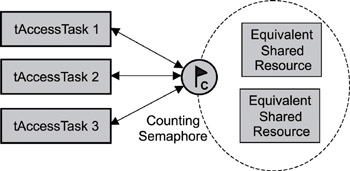Книга: Real-Time Concepts for Embedded Systems
6.4.6 Multiple Shared-Resource-Access Synchronization
6.4.6 Multiple Shared-Resource-Access Synchronization
For cases in which multiple equivalent shared resources are used, a counting semaphore comes in handy, as shown in Figure 6.10.

Figure 6.10: Single shared-resource-access synchronization.
Note that this scenario does not work if the shared resources are not equivalent. The counting semaphore's count is initially set to the number of equivalent shared resources: in this example, 2. As a result, the first two tasks requesting a semaphore token are successful. However, the third task ends up blocking until one of the previous two tasks releases a semaphore token, as shown in Listing 6.6. Note that similar code is used for tAccessTask 1, 2, and 3.
Listing 6.6: Pseudo code for multiple tasks accessing equivalent shared resources.
tAccessTask () {
:
Acquire a counting semaphore token
Read or Write to shared resource
Release a counting semaphore token
:
}
As with the binary semaphores, this design can cause problems if a task releases a semaphore that it did not originally acquire. If the code is relatively simple, this issue might not be a problem. If the code is more elaborate, however, with many tasks accessing shared devices using multiple semaphores, mutexes can provide built-in protection in the application design.
As shown in Figure 6.9, a separate mutex can be assigned for each shared resource. When trying to lock a mutex, each task tries to acquire the first mutex in a non-blocking way. If unsuccessful, each task then tries to acquire the second mutex in a blocking way.
The code is similar to Listing 6.7. Note that similar code is used for tAccessTask 1, 2, and 3.
Listing 6.7: Pseudo code for multiple tasks accessing equivalent shared resources using mutexes.
tAccessTask () {
:
Acquire first mutex in non-blocking way
If not successful then acquire 2nd mutex in a blocking way
Read or Write to shared resource
Release the acquired mutex
:
}
Using this scenario, task 1 and 2 each is successful in locking a mutex and therefore having access to a shared resource. When task 3 runs, it tries to lock the first mutex in a non-blocking way (in case task 1 is done with the mutex). If this first mutex is unlocked, task 3 locks it and is granted access to the first shared resource. If the first mutex is still locked, however, task 3 tries to acquire the second mutex, except that this time, it would do so in a blocking way. If the second mutex is also locked, task 3 blocks and waits for the second mutex until it is unlocked.
- 6.4.2 Multiple-Task Wait-and-Signal Synchronization
- 6.4.3 Credit-Tracking Synchronization
- 15.2.1 Resource Synchronization
- 15.6.3 Resource Synchronization
- 6.4.1 Wait-and-Signal Synchronization
- Практическая работа 53. Запуск Access. Работа с объектами базы данных
- Shared Cache file
- Appendix E. Other resources and links
- Configure Access Control
- Запуск Access. Открытие учебной базы данных Борей
- 7.5.1. Файлы .htaccess
- Основы интерфейса Access 2007




